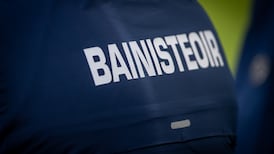IN FOCUS REFEREEING:LAST TUESDAY in Lensbury, a conference centre cum tennis complex in London, the IRB referee manager Paddy O'Brien held the annual IRB High Performance Referees meeting, at which all the officials present were reminded of five key areas of refereeing.
Of the quintet – offside at ruck time, offside from kicks, illegal maul formation, scrum engagement and the tackle law – the latter two were undoubtedly the most contentious during the course of the Ireland-Samoa game.
As he reiterated last week, O’Brien is keen for the referees to ensure strict application of the crouch, touch, pause, engage sequence at the scrum, and backs up his edicts with statistical evidence to show that this has reduced the number of collapsed and reset scrums.
“The 2010 Tri-Nations saw a 40 per cent decrease in the number of scrum resets compared to the 2010 June tier one Tests, so this area of the game is improving. The coaches have all expressed their support of the referee leading the crouch, touch, pause, engage scrum sequence and the sanctioning of players who fail to follow the calling of the engagement procedure, particularly early engagement. The message to the referees is clear. We require greater consistency at the elite level and compliance is critical in this key area of the game,” said O’Brien.
Interestingly, the IRB game analysis also highlights that the 2010 Tri-Nations saw a 50 per cent reduction in scrum collapses compared to the 2010 Six Nations, despite some refereeing crossover between the hemispheres, although perhaps this supports the view that Southern Hemisphere referees apply the scrum engagement sequence more deliberately.
Of course, the timespan of the engagement sequence can vary from referee to referee regardless, France’s Romian Poite causing noticeable difficulty in some of his games this season. However, the delay between crouch and touch, and also between pause and engage, seemed noticeably more pronounced at the Aviva Stadium last Saturday than for any other games this season, and for other games over the weekend, although the IRB believe that it was about the same across all the Tests last Saturday and there were comparatively fewer problems during, say, the Scotland-New Zealand or Wales-South Africa games.
To what degree this contributed to the number of collapsed and reset scrums as two packs waited like coiled springs for seemingly an eternity is a moot point, and by contrast John Lacey did not appear to take as long to carry out the engagement sequence in the Connacht-Samoa game, when there was only one collapsed scrum out of 12.
The IRB have completed a scientific three-year study into the scrums – employing a raft of experts from outside the game as well as inside – and until such time as those results are completely evaluated O’Brien and the IRB believe this is the way to go.
They also cite the Junior World Championship in Argentina in 2010, when there was an 84 per cent scrum completion rate across the 40 matches, though critically, they admit “this was achieved by consistent refereeing performance following buy-in to the directives by the competing coaches”.
In addition to requiring the co-operation of players and coaches, every scrum is something of a guessing game, and while no two referees will oversee every game the exact same way at scrum time, nor can any of them be 100 per cent sure why a scrum collapses or pops up.
Besides which, the plethora of penalties against Ireland at scrum time is a different matter, and many experts – both from the coaching and refereeing fraternity – simply believe Brown had a bad day at the office on his Test debut.
The clearest example of this was the full penalty against John Hayes at an Irish five-metre scrum in the first half when the Samoan loosehead Sakaria Taulafo clearly slipped his bind and twisted to the ground first. And if one team is being penalised three or four times in a row, it does not discourage opponents who are being treated comparatively leniently from messing around. Brown applied one of the other five – offside in front of kickers – barely a minute into the match when he penalised Samoan hooker and captain Mahonri Schwalger, though it appeared as if he could have been stricter in applying the tackle law at the breakdown given how many players failed to roll away.
Next Saturday’s referee is the comparatively experienced Marius Jonker, who fell out of favour with the IRB last year after one bad game and was relegated to the Nations Cup, but has since rebuilt his reputation and status amongst the elite referees.
REFEREEING KEY AREAS REINFORCED BY IRB
The five key areas reInforced last week by IRB referee manager Paddy O’Brien.
- Offsides at the ruck.To afford attacking teams more space referees have been encouraged to apply the "hindmost" foot law more strictly for the last year, although last week's diktat had particular reference for the first defenders and attackers, aka Pillar 1, standing behind the hindmost foot.
- Offside from kicks.Players in front of kicker must not advance until played onside.
- Illegal maul formation causing obstruction.Where before "lifters" would land in front of the catcher to form a maul, now they are being penalised.
- Scrum engagement sequence.You know the routine by now, after the two packs have formed scrums the referee commands them to "crouch, touch, pause, engage" and if either frontrow engages too soon they are penalised with an indirect free-kick.
- Accuracy of application of the tackle law.In particular, tacklers must release the tackled player before endeavouring to play the ball, or roll away.









